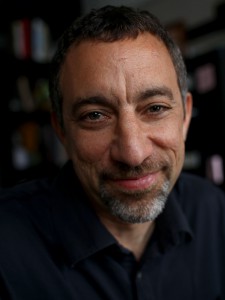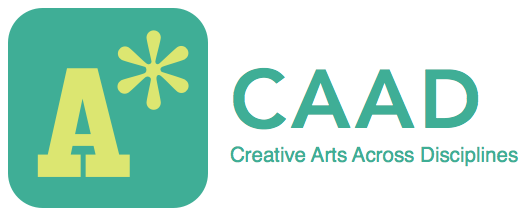Be sure to check out the many CAAD events we have for you this week!
Future Sounds: The Emergence of Cyborgs – Second Sonic Cyborg Residency
As part of Vassar’s second Sonic Cyborg residency, this week Neil Harbisson and Marco Donnarumma will be on campus to share their experiences with us.
Life in the Age of Cyborgs – Lecture by Neil Harbisson
Monday, April 11, 5:30-7:00p
Rocky 200
Neil Harbisson is a Catalan-raised, British-born contemporary artist and cyborg activist best known for having an antenna implanted in his skull and for being officially recognized as a cyborg by a government. The antenna allows him to perceive visible and invisible colours such as infrareds and ultraviolets via sound waves. The antenna’s internet connection allows him to receive colors from space as well as images, videos, music or phone calls directly into his head via external devices such as mobile phones or satellites. Harbisson identifies himself as a cyborg, he feels both his mind and body are united to cybernetics. He doesn’t feel he is using or wearing technology, instead he feels he is technology. His artworks investigate the relationship between colour and sound, experiment the boundaries of human perception and explore the use of artistic expression via sensory extensions. In 2010 he cofounded the Cyborg Foundation with Moon Ribas, an international organization that aims to help humans become cyborgs, defend cyborg rights and promote cyborgism as a social and artistic movement.
Public Conversation with Neil Harbisson and Marco Donnarumma
Wednesday, April 13, 4:00-5:30p
Rocky 200
Corpus Nil – Performance by Marco Donnarumma
Thursday, April 14, 8:00-10:00p
Chapel
Corpus Nil is the new performance by computational sound artist and performer Marco Donnarumma. Two years in the making, this work hybridises the languages of dance, sound art and body art into a tense choreographic interchange between a human performer and an autonomous machine. As the performer moves, the machine uses the bioelectrical voltages and the bioacoustic sounds from his body as the raw material to autonomously generate monolithic sound and light patterns. The human performer and the machine, form a novel kind of body, unknown and partial, disturbing and graceful. As in a trance-like experience, the pulsating rhythm induces visual and auditory effects: while the physical form of the body on stage seems to gradually mutate, its corporeal sound is felt as it was beating within the spectator’s bodies.

Joe Richman, founder and executive director of Radio Diaries.
Telling the Extraordinary Stories of Ordinary Life – Lecture by Joe Richman
Thursday, April 14, 12:00-1:00p
Rosenwald, Vogelstein Center for Drama and Film
Joe Richman is a Peabody Award-winning producer and reporter and the founder of Radio Diaries, a non-profit organization. For two decades, Radio Diaries has helped to pioneer a model for working with people to document their own lives for public radio. Joe has collaborated with teenagers and octogenarians, prisoners and prison guards, bra saleswomen and lighthouse keepers to create award-winning productions including: Teenage Diaries, Prison Diaries, My So-Called Lungs, New York Works, Thembi’s AIDS Diary, Mandela: An Audio History, Willie McGee and the Traveling Electric Chair, and Teen Contender. Joe has worked as a producer on the programs All Things Considered and This American Life. He also teaches at Columbia University’s Graduate School of Journalism. The LA Times called Joe “a kind of Studs Terkel of the airwaves.” A guest artist for the “Producing Audio Narratives” course, Richman will give a lecture on April 14 in the Rosenwald at noon.
Art/Organic/Chemistry
Thursday, April 14, 5:00-7:00p
Frances Lehman Loeb Art Center
Photographer Francesco Mastalia, Professor of Chemistry Miriam Rossi, and curator Mary-Kay Lombino discuss the unexpected intersections between organic farming, art, science, and food. For his 2014 book Organic, Francesco Mastalia used a large format wooden camera and the wet-plate collodion process, developed in the 1850s, to produce one-of-a-kind ambrotype images of more than 100 farmers and chefs of the Hudson Valley who shared with him their philosophy about what it means to grow and live organically and sustainably. “Organic” is one of the most misunderstood words describing food today, and tonight’s gallery discussion will explore the concept from multiple perspectives.
